|
The 2013 Zoos and Aquariums: Committing to Conservation (ZACC) conference runs from July 8th—July 12th in Des Moines, Iowa, hosted by the Blank Park Zoo. Ahead of the event, Mongabay.com is running a series of Q&As with presenters. For more interviews, please see our ZACC feed. |

Maggie Ostdahl at California Ocean Day. Photo courtesy of: Maggie Ostdahl.
The Seafood Watch Program ®, first created by Monterey Bay Aquarium in the late 1990s, is arguably the best-known guide to sustainably-caught seafood in the U.S. Listing seafood choices in three categories—green (best choices), yellow (good alternatives), and red (avoid)—the guide informs consumers of the best options. However, it’s one thing to create a well-respected guide, and another issues altogether to get producers and consumers to use it. But a newer partnership, the San Francisco Seafood Watch Alliance, is working to bridge this gap. Maggie Ostdahl of Aquarium of the Bay works with the Seafood Watch Restaurant program and restaurants across San Francisco—one of the best places in the country for seafood—to source sustainable seafood. Restaurant partners avoid seafood on the guide’s red list.
“Essentially, I get to work with chefs and staff from at least 30 restaurants (and growing!), and I try to be a helpful resource towards their commitment to serving sustainable seafood,” Ostdahl told mongabay.com in a recent interview, adding that “many restaurants in the area are aware of the importance of sustainable seafood, and I do think in most cases it’s not just for trendiness’ sake. However, I would guess that most staff—and many diners for that matter—aren’t fully aware of or make the connection between sustainable seafood and overfishing.”
By getting restaurants involved in the program, it allows diners to pick fish and other dishes out of a menu where sustainability-awareness is already built-in. By eating at any one of the partner restaurants, patrons don’t have to worry about whether or not what’s on their plate is gravely endangered.
Ostdahl says that while overfishing is a major and global problem, it doesn’t mean truly sustainable options are difficult to find.
“Alaska has a long history of healthy fisheries, and in general U.S. fisheries are well-managed,” she notes. “I think this is something to keep in mind while noting that the vast majority of seafood Americans eat (over 80%) is imported from far away. There is also a growing number of aquaculture operations—in the U.S. and abroad—that are working hard to ensure sustainably farmed seafood.”
Maggie Ostdahl will be presenting on her work with the Aquarium of the Bay, San Francisco at the 2013 Zoos and Aquariums: Committing to Conservation (ZACC) conference on Thursday, July 11th in Des Moines, Iowa.
AN INTERVIEW WITH MAGGIE OSTDAHL

Indian Ocean waves breaking on the Western-most part of Java. Photo by: Rhett A. Butler.
Mongabay: What’s your background?
Maggie Ostdahl: I’m a lifelong ocean enthusiast despite growing up landlocked in Pennsylvania. My academic background is a BS in biology and environmental science and policy from Duke, and an MA degree in marine policy from University of Washington. My professional positions span outdoor education, on-water instruction, fisheries scientist, teacher, writer, researcher, policy advocate, activist and sustainability manager. When my mom got tired a few years ago of trying to explain what her older daughter does, I ‘invented’ the term Marine Conservation Professional.
Mongabay: What drew you to marine wildlife?
Maggie Ostdahl: As best I can remember: my first time snorkeling at age 7 with my dad. I am very fortunate to have been able to travel from a young age. I don’t remember which Caribbean reef fish reeled me in, but I was hooked on the ocean.
Mongabay: Will you tell us about the San Francisco Seafood Watch Alliance?
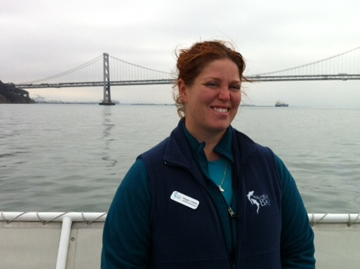 Maggie Ostdahl on ferry in San Francisco. Photo courtesy of Maggie Ostdahl. |
Maggie Ostdahl: Absolutely, that’s my job! The San Francisco Seafood Watch Alliance is a partnership between three San Francisco Bay Area organizations: Aquarium of the Bay (where I work), the San Francisco Zoo, California Academy of Sciences, and the Monterey Bay Aquarium Seafood Watch program. We have all been conservation outreach partners with Seafood Watch for some time, and in 2009 we all decided to formalize a relationship. We provide regional support for Seafood Watch, and I think it has helped all of us become more effective in communicating to our audience(s) and the public about sustainable seafood and the importance of choosing it to help support a healthy ocean.
Our respective roles are basically as follows:
- We all continue to incorporate sustainable seafood messaging in our regular programs and outreach
- California Academy hosts an annual Sustainable Catch Nightlife within the week of World Oceans Day, with cooking demos, games, and lots of info about how and where to find sustainable seafood. Nightlife happens every Thursday evening at the Academy, and is a BIG thing in San Francisco. The crowd regularly numbers over a thousand guests. On June 6 of this year, the Sustainable Catch Nightlife drew approximately 2,800 people.
- The San Francisco Zoo hosts an annual Seafood Watch partner training, where we spend an evening presenting information, updates, and conversation around sustainable seafood for other similar but often smaller organizations around the Bay Area who are working on or are interested in science-based outreach around sustainable seafood.
- The Aquarium of the Bay is the local liason for the Seafood Watch Restaurant Program, an annual program in which restaurants commit to following the Seafood Watch recommendations, and completely avoiding the “red list.” Essentially, I get to work with chefs and staff from at least 30 restaurants (and growing!), and I try to be a helpful resource towards their commitment to serving sustainable seafood.
Mongabay: I assume bluefin tuna is off the menu? What other marine species do these restaurants agree not to serve given their scarcity?
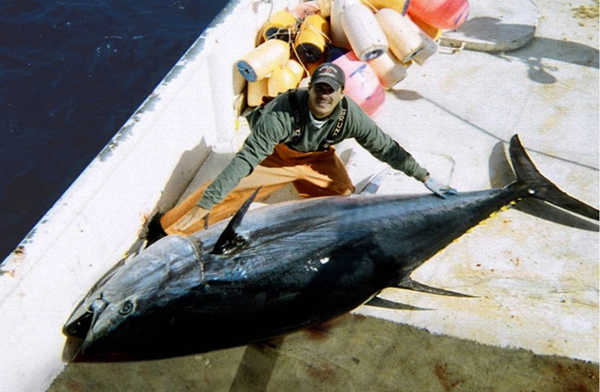
Atlantic bluefin tuna is one of a number species that are on the Avoid List. Photo by: NOAA.
Maggie Ostdahl: In mine and many other expert opinions, bluefin tuna *should* be removed from menus everywhere…or it might be anyway if we as a human species don’t curb our insatiable global appetite. Bluefin tuna—whether wild-caught or ranched—is one of the seafood choices we would encourage people to “Avoid.” Here’s why: Wild-caught bluefin is slow to mature, and these days the older fish are pretty much gone. Catching younger fish before they have had a chance to reproduce is a particularly problematic type of overfishing, for obvious reason. Additionally, the most common gear type used to fish Bluefin is longline gear, or fishing lines that are often miles (40-50 nautical miles) long with millions of hooks. It’s a fairly indiscriminate fishing method that results in a great deal of bycatch of animals like sharks, dolphins, turtles, and seabirds. There are some places (like the U.S.) which is working on reducing longline bycatch, but it’s always a problem.
Ranched bluefin is becoming an approach in various places in the face of declining wild stocks and growing global demand. Bluefin ranching involves young bluefin tuna being caught wild and raised (‘fattened up’) in offshore net pens. Obviously, this doesn’t solve the overfishing problem; and further requires catching smaller feed fish in large quantities, ground up and fed to the bluefin.
I’m deliberately not listing off a number of other red “Avoid” items, because seafood sustainability in my opinion should not focus on a laundry list of things to remember, but rather having interesting conversations of where it is from and how it is caught or farmed. Then, anyone can use handy tools like the free Seafood Watch app or pocket guide, or visit www.seafoodwatch.org.
Mongabay: How difficult is it to get restaurants to agree to serving only certain species?
Maggie Ostdahl: It really depends. Certainly in the San Francisco Bay Area, many restaurants are interested in serving sustainable food, and we can be a helpful resource. Much of my time is getting to talk to chefs for a few minutes about this fish or that supplier, or digging up more info about the sustainability aspects of certain seafood, or connecting them to other culinary professionals or seafood resources. Sometimes I find it challenging to get a restaurant to partner status, but that is more a function of busy schedules and effective communication, rather than a lack of interest in sustainable seafood. And, I think the reason that there aren’t more partner restaurants in the Bay Area is one of capacity and time as well (they may not know about the program or follow-up with me or Seafood Watch if they do hear about it; and I can’t chase around after restaurants. There are a LOT of restaurants in this area, it’s kind of a foodie town).
Mongabay: Do you find that restaurants in San Francisco are generally aware of the overfishing crisis?
Maggie Ostdahl: I think that depends—I know that many restaurants in the area are aware of the importance of sustainable seafood, and I do think in most cases it’s not just for trendiness’ sake. However, I would guess that most staff—and many diners for that matter—aren’t fully aware of or make the connection between sustainable seafood and overfishing. To be fair, it can be complex if you get hung up on the variety of fish species, the variety of fishing methods, the variety of places seafood comes from and the generally complicated supply chain between the water and plate (although that is changing in many places, for the better in my opinion). But at the heart of it, overfishing is pretty simple: on the global average, we are removing fish from the water faster than their populations can reproduce. To compensate (given the human demand for and/or reliance on marine protein), we are farming more and more fish species, and in some cases the aquaculture industry is expanding faster than our understanding and management of environmental impacts. For both of these issues, consumers have the opportunity—and I would argue responsibility—to make good choices to help the ocean.
Mongabay: Has this program been replicated in other cities?

Villagers fishing in Madagascar. Overfishing by industrial fisheries has taken fish from some of the world’s poorest, depriving them of an important source of protein. Photo by: Rhett A. Butler.
Maggie Ostdahl: This is a question better directed to my colleagues at Seafood Watch, but the San Francisco Seafood Watch Alliance is in my understanding serving as a model as the Seafood Watch program continues to grow
Mongabay: Given the scale of overfishing in the world’s oceans, can any fishery be considered sustainable?
Maggie Ostdahl: Yes! It’s good you mentioned the word “scale”—and important to keep in mind that while overfishing happens throughout the world in lots of different contexts…so do a number of examples of responsible fishing that is relatively well-managed. Fish (and invertebrates too) have always been and will always be a crucial protein for humans. For example, Alaska has a long history of healthy fisheries, and in general U.S. fisheries are better managed than other countries. I think this is something to keep in mind while noting that the vast majority of seafood Americans eat (over 80%) is imported from far away. There is also a growing number of aquaculture operations—in the U.S. and abroad—that are working hard to ensure sustainably farmed seafood.
Mongabay: In addition to supporting more eco-friendly fisheries, what can people do to help marine wildlife?
Maggie Ostdahl: I will be kind and limit myself to just 3 bullet points here, in the interests of time and because it is after 5pm on a Friday.
- Keep in mind that we live on an ocean planet—it covers 71% of our planet! All of our everyday actions matter.
- Use less plastic. Not all plastic is bad—we just need to use less, especially single-use plastic (water bottles, sandwich bags, plastic wrap, bubble wrap, etc., etc.) Why? To be blunt, plastic is a leading killer of marine wildlife. Plastic is durable and lightweight, which is great for our convenience, but those qualities mean it can easily blow into the watershed (stream, river, storm drain) and get to the ocean. By then it may be in smaller pieces so it can be easily eaten by even small fish or seabirds. Or, if it’s a larger piece—like say a packing strap or discarded fishing line—it can wrap around an animal’s head and cause severe injury or death. I just returned from a week-long trip to the North Atlantic Gyre, and every sample of surface water contained pieces of plastic. Without meaning to, we are turning our planet into a trashy soup.
- Reduce your carbon footprint, and support good policies on climate change. The warming planet appears to be wreaking havoc on the global ocean, in ways that we’re just beginning to understand. Ocean acidification (increased greenhouse gases into the ocean, which is a carbon sink, actually changes the ocean pH) is rather scary. Warming sea surface temperatures are causing shifts in where marine wildlife lives, and we don’t know yet how much or what impacts this will have on the global food supply.
But! The good news is that we do know that the ocean needs our help, and we do know ways that every person can make a positive difference. What will you do to help your ocean?
Related articles
Monster shark sparks talk of overfishing
(06/06/2013) A giant mako shark caught by a sports-fisherman Monday in California has spurred a conversation about declining shark populations worldwide, reports the Associated Press.
Manta ray tourism worth 28 times more than killing them for Traditional Chinese Medicine
(06/03/2013) A new study in the open access journal PLoS ONE estimates that manta rays are worth $140 million a year in tourism across 23 countries, significantly outweighing the worth of manta ray gill plates, which have become the newest craze in Traditional Chinese Medicine.
Local economy ruined by pesticide pollution in the Caribbean
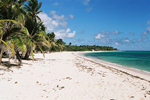
(05/29/2013) On 15 April more than 100 fishermen demonstrated in the streets of Fort de France, the main town on Martinique, in the French West Indies. In January they barricaded the port until the government in Paris allocated €2m ($2.6m) in aid, which they are still waiting for. The contamination caused by chlordecone, a persistent organochlorine pesticide, means their spiny lobsters are no longer fit for human consumption. The people of neighboring Guadeloupe are increasingly angry for the same reason. After polluting the soil, the chemical is wreaking havoc out at sea, an environmental disaster that now threatens the whole economy.
Industrialized fishing has forced seabirds to change what they eat

(05/14/2013) The bleached bones of seabirds are telling us a new story about the far-reaching impacts of industrial fisheries on today’s oceans. Looking at the isotopes of 250 bones from Hawaiian petrels (Pterodroma sandwichensis), scientists have been able to reconstruct the birds’ diets over the last 3,000 years. They found an unmistakable shift from big prey to small prey around 100 years ago, just when large, modern fisheries started scooping up fish at never before seen rates. The dietary shift shows that modern fisheries upended predator and prey relationships even in the ocean ocean and have possibly played a role in the decline of some seabirds.
China ‘looting’ Africa of its fish
(04/24/2013) Just 9% of the millions of tonnes of fish caught by China’s giant fishing fleet in African and other international waters is officially reported to the UN, say researchers using a new way to estimate the size and value of catches. Fisheries experts have long considered that the catches reported by China to the UN’s Food and Agriculture Organization (UNFAO) are low but the scale of the possible deception shocked the authors.
Breaking the mold: Divya Karnad takes on fisheries and science journalism in India

(04/15/2013) Fishing is not a woman’s domain in most countries across the globe. In parts of India there are fishing communities who believe that having a woman onboard a fishing boat brings bad luck. Despite this, Divya Karnad, a scientist who studies marine life in India, has spent several years studying fisheries and their impact on species like sharks and sea turtles. Her work forms a part of global efforts to track declining marine species and encourage more sustainable fishing.
Heavy metal shark meat: dangerous lead levels found in sharks used as fish food
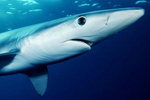
(03/18/2013) A recent study published in mongabay.com’s open access journal Tropical Conservation Science raises concerns about levels of heavy metals, particularly lead (Pb), present in shark meat, as well as the decline of shark abundance due to global fishing pressures. Sharks are primarily caught as by-catch for other fishing industries. By one account, 70% of the total catch in swordfish long-line fisheries was sharks. Due to consumer demand, this by-catch is sold to Asian fish markets as fin and trunk meat. Much of the trunk and organ meat is used to make fish-meal, which is then fed to farmed fish.
Sharks and rays win protections at CITES

(03/11/2013) Today, for the first time, sharks and rays have won the vote for better protection under CITES (the Convention on International Trade in Endangered Species), the world’s regulating body on trade in threatened species. Five shark species and manta rays, which includes two species, have received enough votes to be listed under Appendix II of CITES, which means tougher regulations, but not an outright ban. However, the votes could still be overturned before the end of the meeting.
Has shark fin consumption peaked at 100M dead sharks per year?
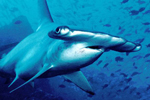
(03/05/2013) While a new study warns that up to 100M sharks are killed annually, there are signs out of China that demand for shark fin may be on the decline. A study published last week in the journal Marine Policy estimated shark deaths at 100 million in 2000 and 97 million in 2010, suggesting a slight drop in shark killing. Meanwhile reports out of China in recent months suggest an accelerating decline in shark fin consumption. China is the top market for shark fin, which is consumed as a status symbol, typically at wedding ceremonies and business dinners.